- Image labeling is crucial for improving the accuracy and effectiveness of machine learning models.
- Choosing the right image labeling tool and an efficient labeling workflow ensures the quality and consistency of labeled images and is important for the success of your machine learning project.
- Clear labeling guidelines, quality control measures and handling challenges are essential for reliable and trustworthy results.
Image labeling is crucial for the success of any computer vision model. However, issues such as class imbalance and a lack of accurately labeled data often affect image categorization and annotation, making it a challenging task.
Further, the inherent complexity of image data can compromise the accuracy and dependability of training datasets. These issues not only impede the development of robust AI models but also drive-up costs and delay product launches, affecting the competitiveness of AI and ML companies.
To tackle these challenges, a deep understanding and strategic approach to image labeling is essential. This involves choosing the right tools, methods, and quality assurance processes. And this guide offers the detailed insights into image labeling for machine learning you need to efficiently overcome these challenges.
Table of Contents
- What Are The Common Challenges in Image Labeling And How To Overcome Them?
- What Are the Best Practices for Image Labeling?
- How to Label Images for Machine Learning: Step-by-Step Guide
- How Automation and AI Are Transforming Image Labeling
- How Transfer Learning Improves Image Labeling Speed and Accuracy
- Active Learning in Image Labeling: How It Enhances Data Efficiency
- How to Balance Speed and Accuracy in Image Labeling Projects
- Best Practices for Managing Large and Diverse Image Datasets
- How to Ensure Consistency and Repeatability in Image Labeling
- How to Handle Imbalanced Classes in Image Labeling for AI Training
- Top Industry Use Cases of Image Labeling in AI and Machine Learning
- Ethical considerations in image labeling
- Collaborating with a labeling team
- Conclusion
What Are The Common Challenges in Image Labeling And How To Overcome Them?
Image labeling can be challenging due to a range of factors, such as lack of correctly labeled data, intra-class variation, scale variation, occlusion, and illumination.
However, these challenges can be overcome by using data augmentation, image resizing, image segmentation, image normalization, detailed annotation guidelines, robust data security measures and efficient quality assurance processes.
Ensuring the quality of labeled images involves building an annotation workflow using a machine-learning-based label quality assurance model, analyzing data and image labeling accuracy, using a pipeline for labeling and verification steps, and ensuring data confidentiality.
What Are the Best Practices for Image Labeling?
Image labeling projects involve both human annotators and automation tools. Expert annotators carefully analyze and interpret images, identifying and labeling objects, regions, or attributes of interest. They use specialized annotation tools and techniques to ensure consistent and accurate labeling.
Let’s explore some best practices that can make image labeling more efficient and effective.
| Best Practice | Why It’s Important | How to Implement |
|---|---|---|
| Consistent Labeling | Why It’s Important Ensures accuracy | How to Implement Develop a clear set of rules |
| Quality over Quantity | Why It’s Important Better results with ML | How to Implement Focus on label precision |
| Use of Tools | Why It’s Important Increases efficiency | How to Implement Utilize image labeling software |
| Regular Reviews | Why It’s Important Improves performance | How to Implement Conduct frequent checks |
Creating a set of clear rules and strictly adhering to them is essential for maintaining accuracy in labeling. Our focus should be on prioritizing quality rather than quantity, as precision is key to the success of machine learning.
In general, its best to adhere to the following practices:
- Labeling Objects of Interest: Each image should have its objects of interest accurately identified and labeled to ensure the training of precise computer vision models.
- Consistency Across Images: Maintaining consistency in labeling conventions, such as using the same class names and bounding box formats, to enhance model training and evaluation.
- Handling Occluded Objects: Being careful to label occluded objects correctly, considering their visible portions, and providing accurate annotations.
- Labeling Everything Important: Labeling all relevant objects and details in an image to ensure comprehensive training data for the computer vision model.
- Ensuring Precision: Zooming in and labeling with precision, especially for small or intricate objects, to help create accurate annotations.
How to Label Images for Machine Learning: Step-by-Step Guide
Precise, pixel-level labeling is necessary in image labeling. It teaches machine learning models to differentiate between different objects, backgrounds, and boundaries within an image. This knowledge allows ML models to perform tasks like object segmentation and instance segmentation. It’s what makes computer vision models able to understand complex scenes with multiple objects, and their interactions.
Industries like healthcare, agriculture, retail, and manufacturing depend on high-quality image labeling for their computer vision applications. The annotation accuracy of training images is linked to their success.
This is why images are labeled through a careful, step-by-step, iterative process. Skipping steps can cause issues with AI or ML model performance in practical settings. And these steps are equally relevant for manual, automated, or AI-assisted labeling.
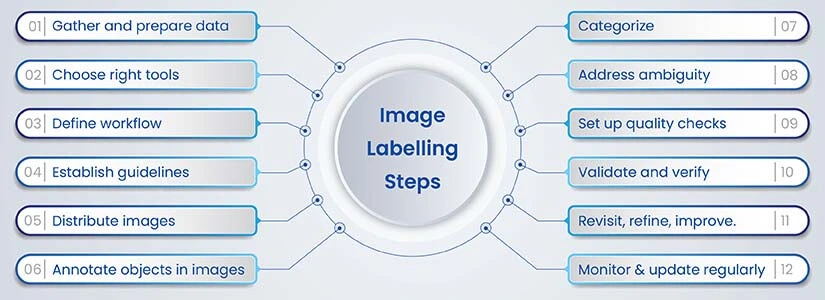
1. Gathering and preparing image data
The first step in the image labeling process is to collect a diverse dataset of images. These images should cover a wide range of scenarios and include all the objects or classes that the model needs to learn. The quality and quantity of data collected directly impact the performance of the trained model.
Before starting to label, you need to make sure the collected image sets are suitable for your machine learning project. This involves utilizing advanced annotation techniques and following image annotation best practices.
To maintain high-quality and consistent datasets, we apply preprocessing techniques. This involves removing duplicate or irrelevant images, resizing, and cropping images to a standardized format and enhancing image quality as needed.
Also, when collecting data, we need to consider the type of machine learning models we’ll be using.
For instance, if we’re using object detection models, our data should include bounding box annotations. For segmentation models, we’ll need polygon annotations.
Annotation techniques and image labeling guidelines also vary depending on the type of machine learning model and its primary task.
Here’s a table to illustrate:
| Machine Learning Model | Annotation Technique | Annotation Best Practice |
|---|---|---|
| Object Detection | Annotation Technique Bounding Boxes | Annotation Best Practice Use varied and representative images |
| Segmentation | Annotation Technique Polygons | Annotation Best Practice Ensure annotations are precise |
| Classification | Annotation Technique Labeling | Annotation Best Practice Balance your dataset |
| Regression | Annotation Technique Points | Annotation Best Practice Normalize your data |
2. Choosing the right image labeling tools
The choice of labeling tool can significantly impact the quality, efficiency, and cost of your project. It is crucial to select a tool that fulfills your specific requirements. Consider these three aspects when thinking about how to select a tool for image labeling?
Ease of use
- Look for an intuitive and user-friendly interface that simplifies the annotation process.
- Consider the tool’s ability to handle large datasets efficiently, allowing for easy navigation and management of annotations.
- Ensure that the tool provides features like zooming, panning, and undo/redo options for precise annotation.
Features
- Ensure that the tool supports the annotation types you require, such as bounding boxes, polygons, key points or semantic segmentation.
- Check if the tool allows for multiple annotations per image and if it supports hierarchical or nested annotations.
- Consider the tool’s ability to handle complex annotations, such as occluded objects or fine-grained details.
- Ensure the tool has quality control and review mechanisms, including features like annotation auditing, automatic error detection, and the ability to easily review and validate annotations.
Integration
- If you are working in a team, consider a tool that supports collaboration, allowing multiple users to work on the same dataset simultaneously.
- Check whether the tool provides version control and annotation tracking features to maintain a clear audit trail.
- Consider the tool’s compatibility with other software or platforms you use, such as machine learning frameworks or data management systems.
By evaluating these factors, you can choose an image annotation tool that meets your needs and maximizes annotation efficiency. Consider project requirements and try out a few tools before deciding.
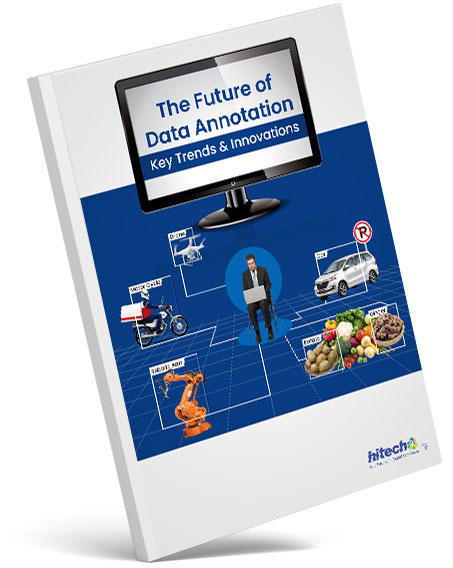
The Future of Data Annotation: Key Trends and Innovations
- Industries globally are impacted by advancements in annotation.
- Smart tools and techniques enhance the performance of ML models.
- Synthetic data and multimodal annotation are trends that will dominate.
- Ethical data annotation practices ensure responsible AI development.
3. Setting up a labeling workflow
After selecting the appropriate image-labeling tool, establish an efficient labeling workflow. This involves defining a process that guarantees quality and consistency in the labeled images. Start by choosing a subset of images for labeling and assigning them to your labelers in batches.
Consider the table below to better understand the workflow:
| Step | Description |
|---|---|
| Step 1 | Description Select a subset of images |
| Step 2 | Description Select a subset of images |
| Step 3 | Description Select a subset of images |
| Step 4 | Description Validate the labeled data |
| Step 5 | Description Integrate the labeled data into ML model |
4. Defining labeling guidelines and standards
To ensure high-quality labeled images for your machine learning project, you need to establish clear and precise labeling guidelines and standards. These guidelines serve as your labelers’ blueprint, giving them a clear understanding of their tasks.
- Define categories: Be specific about what each category represents. For instance, if you are working on a project that identifies objects, clearly state what constitutes each object category.
- Provide examples: Offer samples of correctly labeled images for each category. This helps to visually convey expectations and minimize potential confusion.
- Set accuracy standards: Decide on a threshold for labeling accuracy and communicate it clearly. This acts as a benchmark for quality control, ensuring consistency across all labeled images.
- Conduct training sessions: We regularly familiarize annotators with the annotation task and address any questions or concerns.
- Implement a feedback loop: This helps to address any issues or challenges faced by annotators and incorporate their suggestions for improvement.
5. Distributing images for labeling
In any large project, effectively distributing images for labeling is a crucial step. To achieve this, establish a well-organized folder structure, provide clear instructions to the labeling team, and utilize a collaborative platform for efficient communication and tracking. Following these steps streamlines and optimizes the image labeling process, resulting in more accurate and reliable results.
6. Annotating objects in images
Once you have established your labeling standards, begin annotating objects in your images. This is a crucial step in preparing your dataset for machine learning.
To annotate the objects, manually draw bounding boxes around each one and assign a label. Use a specialized image annotation tool like Labelbox or VGG Image Annotator, or any other to suit your project requirements.
Consistency in placing the bounding boxes and assigning labels is essential. It is your responsibility to ensure that each object is correctly identified and labeled.
The four principal techniques of image labeling that are most used include:
- Bounding Box Annotation: This technique involves drawing rectangular boxes around objects of interest, providing their location and size.
- Semantic Segmentation: In this technique, each pixel in an image is labeled with a corresponding class, enabling precise object boundary delineation.
- Instance Segmentation: Like semantic segmentation, instance segmentation assigns a unique label to each individual instance of an object within an image.
- Keypoint Annotation: This technique involves labeling specific points or landmarks on objects, aiding in tasks such as pose estimation or tracking.
Although it may seem laborious, this process is invaluable in training a machine learning model to accurately recognize patterns in the image data.
You can check out different types of image annotation services in detail as well for a better understanding of the process.
Enhance the performance of your Machine Learning models.
Feed your machines with precise, consistent and reliable labeled data.
7. Categorizing images with tags and labels
After annotating each object in the images, you need to categorize them using tags and labels. This step helps machine learning models better understand the context of the image data.
Here are the steps:
- Assign Labels: Give each object a unique label. It could be the name of the object, a category to which it belongs, or a description of its state or condition.
- Create Tags: Tags are keywords associated with your image. They help the model establish connections between different images.
- Consistency Matters: Maintain a consistent tagging and labeling system across the dataset. This ensures the model’s ability to learn patterns more effectively.
8. Handling ambiguous and uncertain labels
When dealing with ambiguous or uncertain labels in your image dataset, it is important to have an efficient strategy to handle them. Ambiguous labels may arise from image quality, category similarity or subjective interpretation. Uncertain labels, on the other hand, can be the result of unclear image context, content, or categorization.
Consider the following strategies:
| Problem | Solution |
|---|---|
| Problem Ambiguity due to quality | Solution Improve image resolution |
| Problem Similarity between categories | Solution Refine categories |
| Problem Subjective interpretation | Solution Subjective interpretation |
| Problem Uncertainty due to context | Solution Provide annotators with context |
| Problem Uncertain categorization | Solution Establish clear labeling guidelines |
9. Setting up quality control
Establish a strong quality control system for your image labeling process to ensure accurate and consistent labels. This involves:
- Verification: Cross-check labels against known standards. Use a subset of already labeled data for this purpose.
- Multiple Annotators: Have more than one person label the images. This helps identify inconsistencies and improve the overall reliability of your labels.
- Regular Audits: Conduct frequent audits of the labeling process. This helps in identifying any errors or issues early on and allows us to take corrective measures promptly.
10. Validating and verifying labeled images
After labeling images for machine learning, it is essential to validate and verify the accuracy of the labels. This step guarantees that your model is trained on accurate data, crucial for high-performance.
Here’s a simple process to follow:
- Review – Examine a subset of the labeled images manually. Look for consistency and accuracy in the labels.
- Cross-validation – Split the dataset into training and validation sets. Use the validation set to evaluate your model’s performance and rectify any issues.
- Use metrics – Utilize performance metrics like precision, recall, or F1-score to assess the quality of the labels.
Drive cost optimized, precision-driven data labeling projects at scale.
Leverage the combined power of automation and human-in-the-loop.
11. Iterative labeling for continuous improvement
To continuously improve the machine learning project, you need to adopt an iterative approach to labeling. This involves regularly revisiting and refining labels based on feedback from the machine learning model.
By analyzing the model’s false positives and negatives, you can identify common characteristics or patterns and adjust your labels accordingly. This iterative labeling process improves the accuracy of the model over time and enhances your understanding of the data’s nuances and complexities.
It’s important to remember that labeling is an ongoing task of refinement and improvement.
12. Monitoring and updating labels over time
As your machine learning project evolves, you should consistently monitor and update your image labels for maximum accuracy. This is an ongoing process that requires regular check-ins.
Here’s a brief guide on how to accomplish this:
- Regular Review: Conduct periodic audits of labeled images. Check for consistency and accuracy. Mislabeled images can skew the results and degrade the efficiency of your model.
- Update Labels: Based on your reviews, update labels where needed. This could be due to evolving data, changed project requirements, or identified errors.
- Retrain the Model: After updating labels, retrain your machine learning model to incorporate these changes. This will help enhance its performance and maintain its relevancy over time.
How Automation and AI Are Transforming Image Labeling
Automation and AI in image labeling use advanced algorithms and machine learning models to automatically assign descriptive labels to images, providing valuable insights and facilitating efficient image retrieval and analysis.
One of the primary approaches used in automated image labeling is supervised learning. In this technique, a model is trained on a large dataset of labeled images, where each image is associated with one or more predefined labels. The model learns the patterns and features that are indicative of each label, allowing it to predict the appropriate labels for new, unseen images.
Automation in annotation can also be achieved using unsupervised learning, where the model automatically clusters similar images together based on their visual similarities, without any prior knowledge of the labels. This clustering can provide useful insights into the underlying structure and content of the image dataset.
The table below briefly outlines the benefits and potential challenges of using automation and AI in image labeling:
| Benefits of AI and Automation | Potential Challenges |
|---|---|
| Benefits of AI and Automation Reduces human error | Potential Challenges Requires upfront programming |
| Benefits of AI and Automation Saves time | Potential Challenges May lack human nuances |
| Benefits of AI and Automation Can handle large data sets | Potential Challenges May require ongoing adjustments |
Here are some key advantages of automation in image annotation:
- Timesaving: Automation reduces the time needed for image annotation. Through sophisticated algorithms and machine learning techniques, automated annotation tools can efficiently analyse and label vast amounts of images, saving valuable human resources.
- Consistency: Manual annotation can be inconsistent because human annotators may interpret and label images differently. Automation provides consistent and standardized annotations, improving the reliability and comparability of annotated datasets.
- Scalability: Automated annotation tools efficiently handle large datasets, making image annotation projects scalable. This scalability allows for the annotation of extensive image collections, facilitating the development and training of robust machine learning models.
- Cost-effectiveness: Automating image annotation helps organizations save money on manual annotation. With automated tools, we need fewer human annotators, reducing labor costs and improving efficiency.
- Error reduction: Human annotation can be prone to errors, including mislabeling or overlooking objects in images. To address this issue, utilize automation with advanced algorithms and rigorous quality control measures. This approach helps achieve more accurate and reliable annotations.
To make informed decisions about incorporating automation and AI into our image labeling process, you need to understand these factors. Our goal is to establish an efficient and accurate system.
How Transfer Learning Improves Image Labeling Speed and Accuracy
By using transfer learning, you can improve our labeling efficiency for your machine learning project. This technique enables you to utilize pre-trained models, reducing the amount of data we need to label saving time and resources.
Here’s how it works:
- Utilize Existing Models: Transfer learning uses previously trained models on large datasets, allowing you to take advantage of already learned features and patterns.
- Less Labeling Required: By using these models, less data needs to be labeled manually.
- Save Time and Improve Accuracy: This approach not only speeds up the process but also helps to improve the accuracy of the final model, as existing models have been trained and optimized on vast datasets.
Active Learning in Image Labeling: How It Enhances Data Efficiency
In image labeling, active learning techniques have been highly effective in enhancing workflows and boosting the precision of ML models.
Active learning is a form of supervised learning where the model prompts the user to label the most informative instances from the input data. This approach allows you to bypass the labor-intensive task of labeling an extensive dataset. Instead, focus on the instances that the model deems most valuable.
Additionally, this technique sharpens the model’s accuracy by concentrating on training with data that presents more of a challenge. However, over-reliance on active learning can lead to skewed models. For optimal outcomes, it is advisable to integrate active learning with other methods.
How to Balance Speed and Accuracy in Image Labeling Projects
In your labeling process, it is crucial to balance speed and accuracy to maintain quality and meet project deadlines. Ensure that your approach allows you to make progress at a steady pace without compromising the integrity of your data.
Consider the following strategies:
- Automated Tools: Use AI-based tools to expedite the process. These tools can perform preliminary labeling, which you can then refine.
- Batch Labeling: Instead of labeling images one at a time, do it in batches. This way, you can speed up the process without risking accuracy.
- Quality Checks: Implement regular quality checks. This ensures any inaccuracies are caught early and corrected, maintaining the overall quality of your data.
Best Practices for Managing Large and Diverse Image Datasets
When working with big and varied image datasets for our machine learning project, we encounter specific challenges that demand careful planning and strategic approaches.
- Data Partitioning: We divide our dataset into training, validation, and testing sets. This allows our model to learn effectively, adjust its parameters, and evaluate its performance on new data.
- Data Annotation: Large datasets mean more images to label. Use automated labeling tools to save time and maintain consistency coupled with regular quality checks.
- Data Augmentation: Diverse datasets may lack balance. Augment the underrepresented classes by applying transformations such as rotation, flipping, and scaling to existing images. This enhances the model’s ability to generalize.
How to Ensure Consistency and Repeatability in Image Labeling
In managing image datasets, maintaining label consistency is key. It is essential to set up a robust labeling protocol from the outset to ensure accurate machine-learning results. Clear labeling rules must be outlined to cut down on variance and maintain uniform labels across varying images.
Automated labeling tools should be considered to streamline the process and enhance the labeled data’s precision. Cross-verification of labels further enhances efficiency and ensures accuracy.
How to Handle Imbalanced Classes in Image Labeling for AI Training
When dealing with imbalanced classes in the image labeling process for machine learning, you need to prevent bias toward the majority class, which can impair the model’s performance.
Here’s how to tackle this:
- Under sampling: Reduce the majority class to match the minority one. This can lead to the loss of potentially useful information.
- Oversampling: Increase the minority class by duplicating instances or creating synthetic ones. But this might lead to overfitting.
- Class Weighting: Adjust the model’s loss function to assign more weight to the minority class.
Incorporating Contextual Information in Labels
When labeling images, it is important to balance the classes and incorporate contextual information into the labels. This includes metadata or other secondary data that can provide machines with a deeper understanding of the image. For example, the location or time an image was taken can be crucial for certain applications. This information can be included directly in the labels or as separate input features.
Top Industry Use Cases of Image Labeling in AI and Machine Learning
Numerous industries leverage image labeling across a range of applications. For instance, in manufacturing, image recognition is used for defect detection, while in medicine and agriculture, it’s applied for diagnosis and crop analysis. Even in content moderation, image recognition helps by filtering inappropriate or harmful content.
In augmented reality, image labeling has been successfully used to annotate large datasets, thereby creating more immersive and interactive experiences. With the right labeling strategy, high-quality datasets can be created, empowering models to identify objects better and drive accurate results.
The following section will give you a detailed view into the use cases of image labeling across various sectors for optimizing processes and creating value across the board.
Healthcare
 Labeling an enlarged heart in a chest X-ray image
Labeling an enlarged heart in a chest X-ray image
Medical image annotations play a critical role in healthcare specializations, including pathology, radiology, gastroenterology, histology, surgical procedures, cancer detection, ultrasound, and microscopy. They aid in enhancing diagnostic accuracy and patient care through machine learning models. Organizations leverage these labeled datasets to train models that assist in early detection and personalized treatment plans, thus saving lives and reducing costs.
Techniques like semantic segmentation meticulously label medical imagery, such as MRI and CT scans, so AI systems can identify and classify abnormalities with high precision. This involves a workflow where radiologists and annotators work together, using advanced tools to ensure each pixel is accurately categorized. This helps to identify tumors, fractures, and other medical conditions.
Moreover, data augmentation methods are utilized to increase the diversity and volume of training data, which helps in improving the robustness of AI models against a variety of cases.
Companies like Floy, RapidAI, and Stanford Medicine have significantly reduced annotation time and experiment duration using AI-assisted labeling in medical images.
Retail & E-commerce
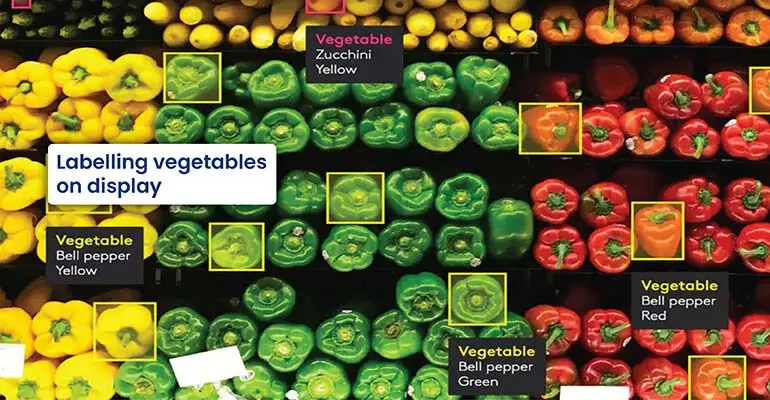 Labelling vegetables on display
Labelling vegetables on display
Image recognition in e-commerce enhances product searches and categorization, improving customer experience and sales conversion rates. Large e-commerce brands, such as Google, Bing, Amazon, and eBay, leverage this technology for more effective retail experiences.
The technology benefits both customers and businesses by offering quick product identification, automatic classification, and visually driven recommendations
ASOS, a British online fashion retailer, used image labeling to enhance their recommendation engine, leading to increased customer engagement and sales. ASOS employed machine learning algorithms to tag and categorize numerous product images, enabling more precise product recommendations and search results.
Similarly, Walmart used image labeling techniques to automate and streamline their inventory management process. By labeling shelf images in real-time, their system could identify stock levels, ensuring shelves are restocked promptly and inventory is accurately tracked. This method reduced manual stock checks and improved inventory accuracy.
Retailers have reported increased sales and reduced operational costs as a direct result of implementing these image labeling solutions.
Automotive
 Using bounding box to detect nearby cars
Using bounding box to detect nearby cars
In the automotive industry, image labeling is needed for autonomous driving systems and advanced driver-assistance systems (ADAS). By harnessing sophisticated image annotation techniques , companies train machine learning models to recognize and interpret various road scenarios.
For instance, automotive giants like Tesla have leveraged this technology to improve its Full Self-Driving (FSD) capabilities. They utilize a combination of labeling strategies that enables the creation of datasets that accurately reflect the diverse and unpredictable nature of real-world driving conditions, leading to more reliable and safer autonomous driving features.
Here is an overview of the techniques used:
| Technique | Application | Outcome |
|---|---|---|
| Semantic Segmentation | Application Pixel-level scene understanding | Outcome Improved object recognition |
| Bounding Box Annotation | Application Object detection and localization | Outcome Enhanced vehicle and pedestrian safety |
| Bounding Box Annotation | Application Depth perception in 3D space | Outcome Accurate environment mapping |
By continuously refining these methods, the industry is making significant strides in achieving full autonomy and improving road safety.
Fashion
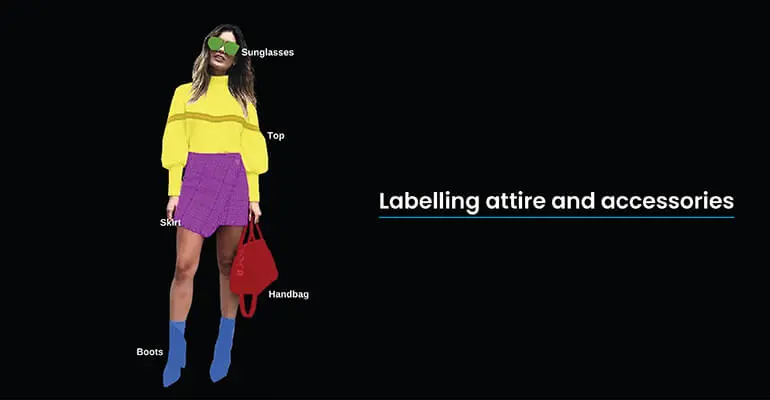 Labelling attire and accessories.
Labelling attire and accessories.
One of the most significant applications of image annotation in fashion is in the development of AI-powered virtual fitting rooms and smart visual search applications.
Through accurate labeling of clothing items using techniques like polygon annotation, the datasets capture the complexity of current fashion choices, which is crucial for the success of AI models in providing virtual fitting experiences.
Additionally, fashion photo annotation, involves using advanced machine learning technology to apply accurate text labels to photos in an image dataset. It automates the manual tagging process required for categorizing product images, enhancing searchability and organization.
The accuracy and consistency of fashion photo annotation enable companies to quickly bring desired products to market and ensure customers find precisely what they are looking for when shopping online or in-store.
HitechDigital successfully annotated 1.2 million fashion images in just 12 days for a Californian technology company, enhancing AI/ML model performance for retail applications. Read in detail about this story here.
Real Estate
 Real estate property features labeling
Real estate property features labeling
Image labeling in real estate facilitates managing user-generated content on online platforms. Advanced algorithms trained with accurately labeled datasets have enabled the creation of detailed 3D property tours and feature recognition for automated valuation models.
For instance, labeling features such as swimming pools, garden size, and the condition of properties helps in refining comparative market analyses. Moreover, the categorization of interior images by room type enhances search filters on platforms, improving user experience.
These techniques have helped detect unauthorized changes in property images, preserving listing integrity. This efficient workflow improves professionals’ productivity and enhances customer engagement through interactive and informative listings.
Courier Delivery Companies
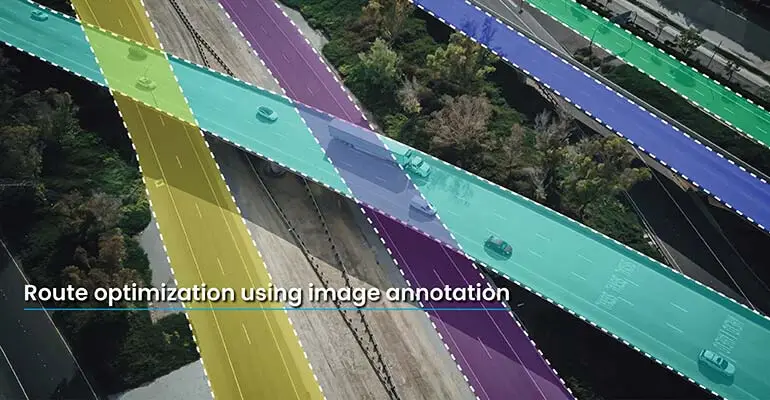 Route optimization using image annotation
Route optimization using image annotation
Courier delivery companies are increasingly using image annotation and AI to improve efficiency and customer service. These technologies enable the precise sorting of packages in distribution centers through barcode scanning and augmented reality, reducing errors and speeding up the distribution process.
AI applications assist delivery personnel by quickly identifying the correct package using smartphone scans, and also provide real-time delivery information. They further streamline the delivery process by facilitating proof of delivery and contactless signing.
Route optimization is another key benefit. AI algorithms analyze extensive data to determine the most efficient delivery routes, adjusting in real time for variables like traffic and weather, thus cutting down on transportation costs and improving customer satisfaction.
In broader logistics, AI, trained through image and video annotation, aids in navigation and vehicle guidance, enhancing overall decision-making and operational efficiency.
AI also plays a crucial role in demand forecasting and customer service, offering automated updates and responsive chatbots. Additionally, it improves load and capacity management, optimizing resource utilization and enhancing last-mile delivery efficiency.
HitechDigital improved courier delivery operations for one of the world’s largest express transportation organization by integrating satellite imagery with mapping tools to add navigational data, reducing delivery times and improving overall efficiency.
Agriculture
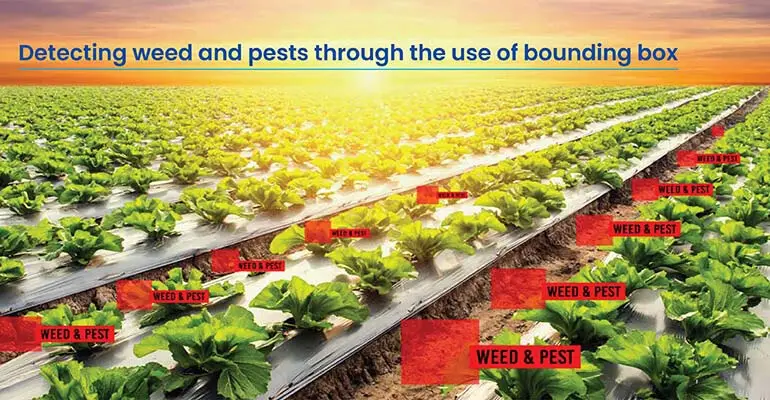 Detecting weed and pests through the use of bounding box
Detecting weed and pests through the use of bounding box
In agriculture, image labeling enables machines to perform actions such as seed planting, weed handling, monitoring productivity growth, and sorting fruits and vegetables. It also plays a significant role in tasks like sorting harvested fruits and vegetables, monitoring the health of soil, animals, and crops, and predicting crop yields.
image labeling is used for accurate crop monitoring and management. It allows AI-enabled machines to detect and recognize various objects in agricultural fields. This is crucial in precise agriculture and farming, aiding in tasks such as harvesting, crop health monitoring, and improving crop productivity.
Advanced techniques such as satellite imagery and drone-based surveillance are used to collect vast amounts of visual data, which are then labeled to identify various crop types, detect diseases, and assess crop maturity levels.
For instance, machine learning models trained with labeled images can pinpoint areas of stress in a field due to pests or water shortage, allowing for targeted intervention.
The effectiveness of these methods has been demonstrated in use cases such as vineyard management, where disease detection algorithms have led to a reduction in pesticide use and an increase in overall yield.
Finance
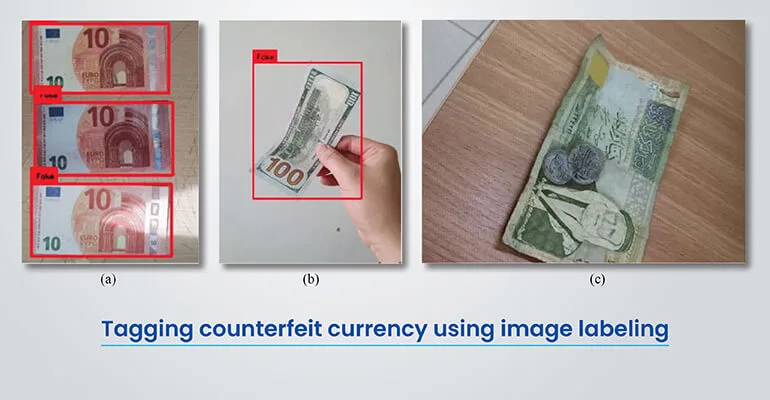 Tagging counterfeit currency using image labeling
Tagging counterfeit currency using image labeling
In the finance sector, image labeling aids institutions to handle document analysis and fraud detection. By employing sophisticated machine learning algorithms, banks and financial entities automatically classify and extract information from a variety of document types, including checks, invoices, and identity documents.
Image labeling is also used to automate the processing of loan applications. Techniques such as semantic segmentation and object detection have been applied to segment and categorize various elements within application forms, thus significantly reducing manual review time and increasing processing efficiency.
Furthermore, image labeling has been instrumental in detecting counterfeit currency, with systems trained to recognize and flag inconsistencies in currency images. The industry has seen a marked improvement in workflow, with a reduction in both processing errors and fraudulent activities.
| Use Case | Technique | Impact |
|---|---|---|
| Document Analysis | Technique Object Detection | Impact Object Detection |
| Fraud Detection | Technique Semantic Segmentation | Impact Reduced Fraud Cases |
| Loan Processing | Technique Image Classification | Impact Efficiency Gains |
Tourism & Travel
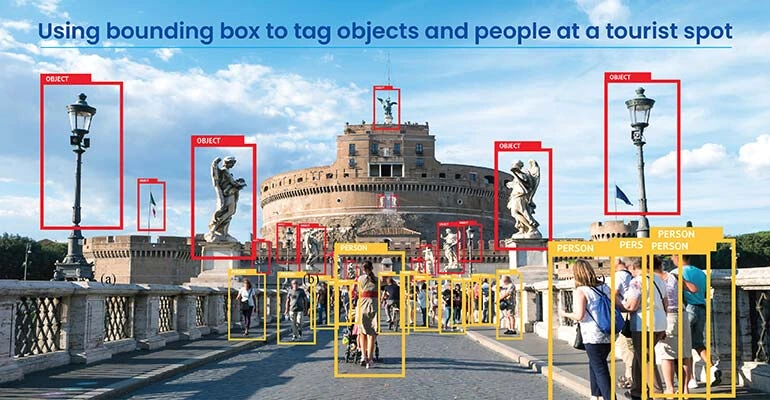 Using bounding box to tag objects and people at a tourist spot
Using bounding box to tag objects and people at a tourist spot
In tourism and travel, image labeling has improved the strategies in which destinations and services are marketed to potential travelers. By employing sophisticated machine learning algorithms, tourism-related businesses can now sort through massive photo libraries to identify and categorize images, enhancing the discoverability of their offerings.
For instance, a travel platform might use image labeling to automatically tag photos with keywords like “sandy beach,” “mountain hiking,” or “urban nightlife,” streamlining the user experience for those searching for specific vacation experiences.
Additionally, augmented reality (AR) applications have greatly benefited from accurately labeled images, allowing tourists to receive real-time information about landmarks simply by pointing their smartphone cameras at them.
The use of facial recognition technology in airports and hotels, improving security and customer service by swiftly identifying guests. These applications rely heavily on the precision of labeled training data to function effectively.
Ethical Considerations in Image Labeling
In image labeling, it is important to be aware of the ethical considerations involved.
- Data Privacy: Ensure the images you are using haven’t been obtained illicitly and don’t infringe on individual privacy rights.
- Informed Consent: If the images involve human subjects, it’s essential they’ve granted informed consent for their images to be used in this manner.
- Bias Prevention: Be mindful of potential biases during the labeling process. Incorrect or biased labels can skew the machine learning model, leading to unjust outcomes.
Keep in mind that ethical considerations aren’t an afterthought—they’re integral to the responsible development and application of machine learning technologies.
Collaborating With a Labeling Team
When working with a labeling team, you will find that communication and coordination are essential for achieving accurate and consistent image labels. This process involves syncing labeling conventions and ensuring everyone understands the project’s goal.
To foster collaboration, use a shared platform for labeling tasks. This setup allows for real-time updates and prevents duplication of work. It’s important to establish a feedback loop. Regularly check in with the team, address questions, and clarify any confusion.
Successful collaboration ensures high-quality, reliable labeled data for your machine learning project.
Conclusion
Image labeling plays a crucial role in enhancing machine learning performance, providing valuable information to computer vision models about the objects present in an image. By accurately annotating images with meaningful and informative labels, machine learning algorithms can better understand and recognize the features of interest.
Successful image annotation involves predetermined labels assigned by machine learning engineers, adherence to annotation guidelines, and the use of various annotation techniques.
Automation tools can streamline the annotation process, but human expertise and feedback remain essential for ensuring high-quality annotations. Collaboration between data labelers and machine learning engineers, along with continuous evaluation and refinement, contribute to optimizing machine learning performance through image labeling.







